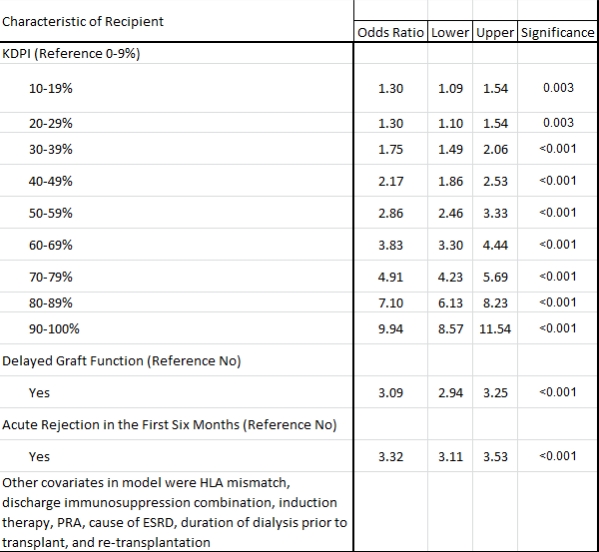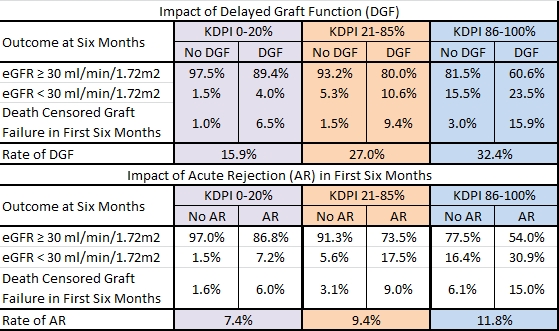The Impact of Early Acute Rejection and Delayed Graft Function on Graft Outcomes at Six Months in Adult Deceased Donor Kidney Recipients.
University of Virginia, Charlottesville, VA.
Meeting: 2016 American Transplant Congress
Abstract number: 46
Keywords: Donors, Glomerular filtration rate (GFR), Graft function, Kidney transplantation, marginal
Session Information
Session Name: Concurrent Session: Kidney Transplantation: Outcomes, Matching and Marginal Donors
Session Type: Concurrent Session
Date: Sunday, June 12, 2016
Session Time: 2:30pm-4:00pm
 Presentation Time: 3:30pm-3:42pm
Presentation Time: 3:30pm-3:42pm
Location: Ballroom B
Graft function as determined by GFR is an important predictor of long-term graft and patient survival after deceased donor kidney transplantation. KDPI is an important predictor of GFR.
We sought to determine the factors that influence suboptimal outcomes after deceased donor kidney transplant. We defined a suboptimal outcome as any death censored graft failure during the first six months post-transplant or CKD stage IV or V (eGFR less than 30 ml/min/1.72m2 calculated by the CKD EPI equation) at six months. We looked at the following factors: KDPI, recipient cause of ESRD, duration of dialysis, acute rejection in the first six months, delayed graft function, discharge maintenance immunosuppression and induction regimen. We used the SRTR database to identify all adult deceased donor kidney transplant recipients between January 1, 2005 and August 31, 2013. We included all recipients with at least 6 months of follow-up or death or graft loss prior to six months (N=81,505).
Table 1 shows the results of logistic regression for a suboptimal outcome. The most important factors influencing suboptimal outcomes were higher KDPI, early acute rejection and delayed graft function. Other factors had only a minor impact on outcomes. Table 2 shows the outcomes of recipients based on the allocation KDPI groups (0-20%, 21-85% and 86-100%) and whether the candidate had delayed graft function or acute rejection in the first six months.
The most important factors influencing suboptimal outcomes were higher KDPI, early acute rejection and delayed graft function. Other factors had only a minor impact on outcomes. Table 2 shows the outcomes of recipients based on the allocation KDPI groups (0-20%, 21-85% and 86-100%) and whether the candidate had delayed graft function or acute rejection in the first six months.  Recipients of high KDPI kidneys who had rejection or delayed graft function had a 40-45% risk of having graft loss or eGFR <30.
Recipients of high KDPI kidneys who had rejection or delayed graft function had a 40-45% risk of having graft loss or eGFR <30.
Preventing rejection and delayed graft function should be a priority when transplanting high KDPI kidneys. More aggressive immunosuppression, pumping of donor kidneys, and limiting cold ischemia time may improve outcomes for recipients of high KDPI organs.
CITATION INFORMATION: Keith D, Vranic G, Nishio Lucar A. The Impact of Early Acute Rejection and Delayed Graft Function on Graft Outcomes at Six Months in Adult Deceased Donor Kidney Recipients. Am J Transplant. 2016;16 (suppl 3).
To cite this abstract in AMA style:
Keith D, Vranic G, Lucar ANishio. The Impact of Early Acute Rejection and Delayed Graft Function on Graft Outcomes at Six Months in Adult Deceased Donor Kidney Recipients. [abstract]. Am J Transplant. 2016; 16 (suppl 3). https://atcmeetingabstracts.com/abstract/the-impact-of-early-acute-rejection-and-delayed-graft-function-on-graft-outcomes-at-six-months-in-adult-deceased-donor-kidney-recipients/. Accessed December 18, 2025.« Back to 2016 American Transplant Congress
